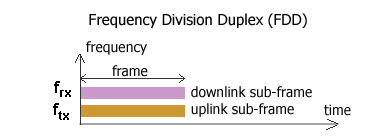Downlink and Uplink
Uplink and downlink are two physical links. Downlink is the one from the base station to user equipment while uplink is the one from the user equipment to base station.Duplexing
Duplexing allows simultaneous communication between uplink and downlink. There are two basic types of duplexing: (1) Time Division Duplexing (TDD); (2) Frequency division duplexing (FDD). The duplexing allows simultaneous services between downlink and uplink. Assume that a video streaming from downlink, and a picture uploading at uplink. A voice call with the duplexing makes the conversation more interactive.TDD uses single frequency band and shares it between downlink and uplink. The durations of dwell time in downlink mode, and uplink mode are in the multiple of 1 milliseconds in LTE-TDD. The switching time becomes critical and it takes 1 ms in LTE-TDD. There are many other challenges in LTE-TDD but its benefit is more flexible resource assignment between uplink and downlink.
Figure above shows FDD where there are two frequency band assigned, one for downlink and one for uplink. 3GPP WCDMA, GSM/EDGE are some example systems that use FDD. The difference between uplink carrier frequency and downlink carrier frequency is called duplex spacing.
Frequency Spectrum and Channels
The frequency regulatory bodies like FCC in USA, ETSI in Europe, TELEC in Japan, designate the spectrum in their geographical regions. Within their region, they arrange the spectrum available according to the target technologies, market areas (either national, or regional). 850 MHz Cellular band in USA, 900 MHz Cellular band in Europe are some examples. These are arranged as FDD. Band 40 in 3GPP is LTE-TDD band.Channel raster is the minimum resolution of carrier frequency arrangement. In 3GPP system it is 200kHz. The numbering is done according to the left edge of the band and the raster.
Previous
Next




No comments:
Post a Comment